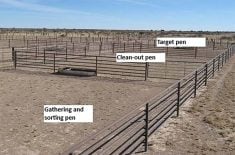In a recent column, I discussed new research by myself and colleagues at the University of Calgary that identified a deadly tapeworm parasite in wild muskrats. A reader suggested I expand on the human and dog aspect of this emerging disease.
Just to briefly recap, the parasite is a tapeworm known as Echinococcus multilocularis. Animals in the canine group (coyotes, wolves, foxes and domestic dogs) are the major carriers of the adult parasites. Tapeworm eggs are present in their feces if they are infected. Poop with eggs contaminate the environment and are inadvertently picked up by new hosts.
Read Also

Beef cattle more prone to trace mineral deficiencies
The trace mineral status of our cows and calves is a significant challenge for western Canadian producers and veterinarians.
The normal, wildlife lifecycle continues when a rodent such as a mouse, vole or muskrat eats eggs. They develop the parasitic liver cysts known as alveolar echinococcosis (AE). When a canine eats them, the tapeworm reaches maturity in the predator’s intestines and starts to produce eggs, completing its lifecycle.
There are many unknown factors regarding the risk of humans acquiring this tapeworm disease. In North America, it used to be rare, but at least 17 people in Alberta have contracted the disease since 2013. Most of these people live in rural areas and own dogs, although some folks were urban dwellers. Some had concurrent diseases that compromised their immune system (e.g., cancer chemotherapy). The disease may develop many years after people or pet dogs have been exposed.
There have been 27 cases in pet dogs in Western Canada between 2009 and 2021, 18 in Alberta. The number of people and pet dogs known to be infected is likely just the tip of the iceberg of the actual infections out there. This is partly because the liver cysts can be challenging to diagnose in both dogs and people.
Clinical signs in dogs and people are non-specific and can include abdominal swelling and pain, malaise and weight loss. With medical imaging techniques such as ultrasound and CT scans, the liver cysts may resemble cancer. And since liver cancer (both primary cancers of the liver and those cancers that arise elsewhere and spread to the liver) are common, that is what is likely to be the preliminary diagnosis. The fact that veterinarians and physicians have a low index of suspicion for the tapeworm means it is less likely to be diagnosed.
Determining if it is the tapeworm requires a biopsy of the cyst, which is invasive, expensive and risky. Treatment involves surgery and lifelong antiparasitic medication.
It is likely that our pet dogs are functioning as a canary in the coal mine. There have been dog cases and studies of coyote carriers in all the western Canadian provinces, indicating that the parasite is widespread. It is reasonable to predict that increasing numbers of people will be diagnosed with the parasite across the region and not just in Alberta.
So what is the average farm family and outdoor enthusiast to do? Although there are many unknown factors about how people become infected, it is suspected that people pick up eggs from contaminated food, soil or from the fur of pet dogs.
Since we have by far the closest contact with our pet dogs compared to other hosts, it is important to follow a regular and effective tapeworm deworming regime.
Only specific deworming medications work to eliminate tapeworm, so be sure to have this discussion with your veterinarian. If possible, reduce or eliminate dogs eating rodents. This includes proper disposal of trapped rodent carcasses such as mice and muskrats.
Clean up canine feces from outdoor areas. Limit contact with coyotes and their feces. Exclusion fencing to keep dogs and wild canines out of vegetable gardens where they could deposit tapeworm eggs may be helpful.
Wash garden produce carefully before consuming it. Thorough hand washing is recommended after being outdoors and handling anything that could have egg contamination such as vegetation and animal feces.
Ontario has taken the national lead on tracking this disease. It has also approached this holistically. Any case of the liver form, whether it is in a human or animal, must be reported to the provincial health authorities. We should take this step on the Prairies as well.















